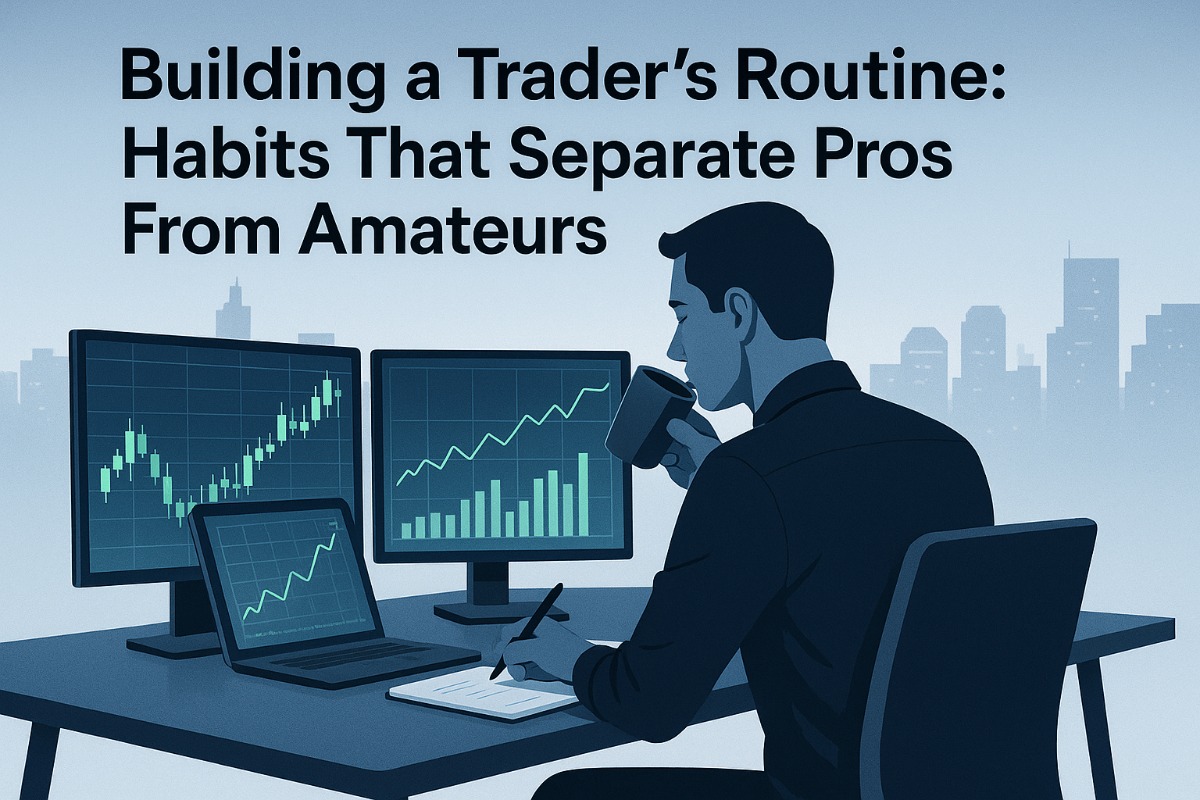Mastering the First Hour: Key Strategies to Win the Market’s Most Volatile Time
Sep 22, 2025 2:35 pm
Building a Trader’s Routine: Habits That Separate Pros From Amateurs
Every successful trader has one thing in common: structure. While markets may seem unpredictable, the habits and routines behind the best traders are remarkably consistent. Building a trader’s routine isn’t about rigid schedules-it’s about creating a framework that keeps your mind sharp, your risk managed, and your emotions in check.
If you’ve ever wondered why some traders consistently outperform while others constantly chase their losses, the answer often lies in the daily habits they follow. Let’s break down the essential routines that separate professionals from amateurs-and how you can adopt them.
Morning Preparation: Starting Strong
The day doesn’t begin when the market opens. Pro traders start long before that bell rings.
- News Scan: Professionals spend 15–30 minutes reviewing financial headlines, global events, and economic calendars. They’re not reacting blindly to headlines—they’re identifying context. Amateurs, on the other hand, often learn about “big news” only after volatility hits the chart.
- Market Review: Before trading, pros analyze overnight price action, futures, and key levels of support and resistance. This helps them frame expectations for the day ahead.
- Mindset Reset: Many top traders treat mental readiness like athletes. Meditation, journaling, or even a simple routine like stretching prepares them for high-pressure decisions.
Key takeaway: Trading starts before the charts-it starts with mindset and preparation.
Discipline as a Competitive Edge
Discipline in trading isn’t glamorous. It’s not about bold calls or high-stakes bets. It’s about consistency, rules, and emotional control. Here’s why it matters:
- Risk Management Always Wins
- A single bad trade without stop-losses can wipe out weeks (or months) of progress. Disciplined traders know their maximum risk per trade before entering - and they stick to it.
- Process Over Prediction
- Instead of obsessing about whether the next move is up or down, disciplined traders focus on execution. Did I follow my setup? Did I respect my risk parameters?
- Long-Term Survival
- Markets reward survival. The trader who manages to stay in the game long enough will have more opportunities than the one who chases every shiny idea and burns out.
Defining the Trading Plan
Amateurs often sit down and “see what happens.” Pros never trade without a plan.
A strong daily plan includes:
- Target Assets: What pairs, stocks, or cryptos will you trade today? (Narrow focus beats scattered attention.)
- Entry & Exit Levels: Predefined areas where you’ll enter or exit a trade.
- Risk Allocation: The percentage of your account you’re willing to risk per trade (commonly 1–2%).
- Scenarios: “If price does X, I’ll do Y.” Professionals plan responses, amateurs improvise under stress.
Having a written plan-even a short checklist-reduces emotional decisions and gives you something concrete to evaluate later.
Execution Habits: Acting With Discipline
Once the market opens, discipline makes the difference.
- Position Sizing: Pros adjust trade size based on volatility and risk, not emotion or “gut feeling.”
- Stop-Loss Respect: Amateurs move or ignore stop-loss orders; pros treat them as sacred.
- No Overtrading: Amateurs jump in and out all day; pros stick to their setups and wait for quality.
Discipline isn’t glamorous, but it’s profitable. Each trade is a data point-professionals think in terms of probabilities, not single wins or losses.
Breaks and Downtime: Avoiding Burnout
Ironically, one of the most important habits is knowing when not to trade.
- Scheduled Breaks: Professionals step away from screens to reset, ensuring they’re not glued to noise or tempted into revenge trades.
- Physical Health: Nutrition, exercise, and rest directly affect decision-making speed and emotional resilience.
- End-of-Day Review: Instead of “forgetting the day,” pros reflect: What went right? What can improve? This feedback loop creates exponential growth.
Amateurs often equate more screen time with more profit-yet most big mistakes happen when fatigue sets in.
Weekly & Monthly Routines: Beyond the Daily Grind
Top traders don’t just think about today; they zoom out.
- Weekly Review: On weekends, professionals review every trade, update watchlists, and adjust strategies.
- Monthly Reflection: Pros look at performance metrics like win/loss ratio, risk-to-reward, and emotional control.
- Adaptation: Markets evolve, so strategies must evolve too. Amateurs cling to one “holy grail strategy,” while pros tweak their systems constantly.
The Mindset Shift: From Gambler to Operator
At the heart of the pro vs. amateur divide lies one key shift: treating trading as a business, not a lottery ticket.
Professionals view themselves as operators running a system-inputs (capital, time, data) lead to outputs (returns). Amateurs view each trade as a make-or-break bet.
This mindset shift is what makes routines sustainable. It turns trading from chaotic swings into structured execution.
Conclusion
A trader’s routine isn’t about rigid rules-it’s about consistency. From morning preparation to end-of-day reflection, the small habits you adopt compound into big results.
Whether you’re just starting out or looking to level up, remember: pros aren’t born-they’re built through habits. By developing your own trader’s routine, you’re not just aiming for profits-you’re building the discipline and structure that keep you in the game for the long run.
Key Takeaways
- Start early: News, charts, and mindset prep matter.
- Plan ahead: Never trade without predefined risk and targets.
- Respect discipline: Stop-losses and position sizing are non-negotiable.
- Review and reflect: Growth happens when you analyze both wins and losses.
- Think long term: Weekly and monthly reviews keep you ahead of amateurs.
